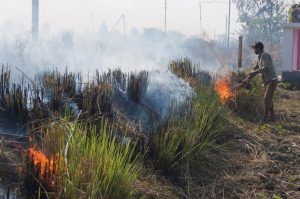Packing winds of 160-170 kilometres per hour (kmph) gusting up to 190 kmph near its centre, Cyclone Amphan, officially described as “extremely severe”, started to make landfall along India’s West Bengal coast around 2.30 pm local time on Wednesday. The eye of the storm was 35 km to the south of Sagar Island on the mouth of the Hooghly river at the time. Flowing past Kolkata, the Hooghly is the westernmost distributory of the Ganga.
The India Meteorological Department (IMD) said the entire storm would take around four hours to cross over to land.
Amphan has started landfall during low tide, which is lucky, because it will minimise the associated storm surge. Experts are hoping that landfall will be completed before high tide sets in. Two days before the new moon, the high tide is strong anyway.
However, Sudhir Karmakar, a resident of Gosaba in the Sundarbans, said that the water had hardly receded during low tide on Wednesday. He and his neighbours had worked throughout last night to strengthen the dyke around their village and raise its height. He shared a video of water almost overtopping the raised dyke even at low tide. “I don’t know what will happen at high tide,” Karmakar said. “The river is already going wild.” Gosaba is relatively far from the coast, but the entire Sundarbans – the world’s largest mangrove forest – is in the tidal zone.
The cyclone is still forecast to move north by northeast, which will take its eye through the eastern fringes of Kolkata, the metropolis where wind and rain have already picked up significantly.
Before the cyclone reached land, the West Bengal government evacuated over 200,000 residents of coastal villages.
The Bangladesh government was reported to be evacuating an estimated two million people from its coastal region at the same time. The path forecast for Cyclone Amphan does not take it through coastal Bangladesh – it is expected to enter the country much further north. But the previous Cyclone Bulbul that hit the same coast last November had changed direction and moved parallel to the shoreline from west to east, India to Bangladesh. So the authorities in Bangladesh are taking no chances.
The current wind intensity around the centre of Amphan is serious enough to bring down trees and overhead electrical wires, take tin roofs off mud huts and maybe collapse the huts altogether. India’s National Disaster Response Force is on hand with tree-cutting equipment – among others – so that fallen branches can be removed easily and roads can be reopened quickly once the cyclone passes.
The storm surge can still be devastating. At 3 pm on Wednesday, IMD forecast that in Bhangar-1 block of South 24 Parganas district in West Bengal, the waves can be as much as 4.3 metres higher than usual, and saline water can cause inundation up to 17 kilometres, not just from the coast but also from the rivers and creeks that meet the coast.
Even in Basirhat block of North 24 Parganas district, relatively far from the coast, the forecast says the waves can be 3.9 metres higher than usual, and the inundation can spread around 10 km. For Diamond Harbour on the way to Kolkata up the Hooghly, waves can be up to 3.5 metres higher than usual, and inundation in the relatively lower area can go up to 17 km from the river.
Apart from the damage caused by the waves, such inundation would mean economic ruin for hundreds of thousands of people, as salt water would kill their crops, all the fish they rear in freshwater ponds and render their farmland infertile for years.
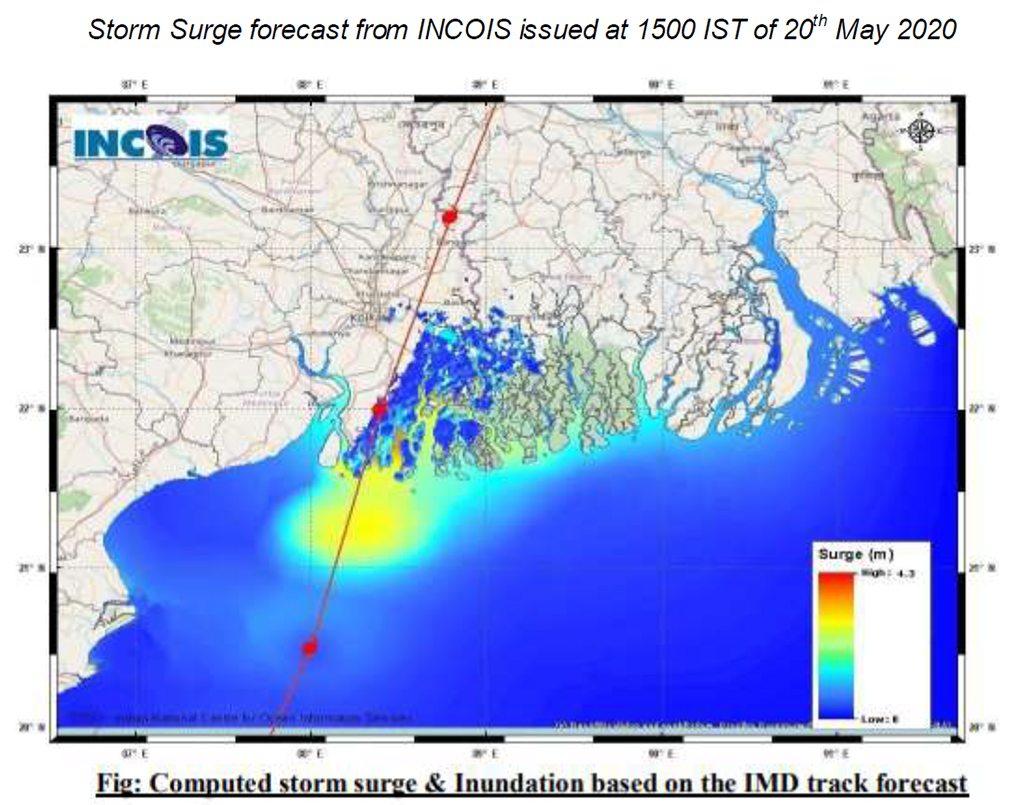
The infection risk
The West Bengal government has moved the evacuees into the same shelters where hundreds of people are already quarantined to prevent Covid-19 infection – in college and school buildings, Panchayat (local government) offices, health centres and so on.
Officials overseeing the evacuation said everyone had been checked for fever before being let into the shelters, all had been given masks, and hand sanitisers were being used regularly. But they admitted that it was impossible to maintain a distance of three feet around each person – the minimum distance enjoined to prevent the spread of the ongoing pandemic.
This is the area to which thousands of migrant workers have returned when they lost their jobs all over India due to the lockdown forced by the Covid-19 pandemic.
See: People rush back to the Sundarbans, untested
Speaking on the condition of anonymity, a local official said, “There is no other place to house the evacuees. Covid-19 infection is a strong possibility in these shelters. But if we don’t evacuate people from the coast, death by drowning and falling homes is a far stronger possibility. We are having to make a very tough choice.”
Residents are anyway reluctant to move to shelters because they have to abandon their livestock and are afraid of thieves. Some also want to be on hand so that they can at least try to repair dykes broken by the storm. Due to shortage of labour in the first days of the lockdown, some of the paddy crop along the coast has not been harvested yet.
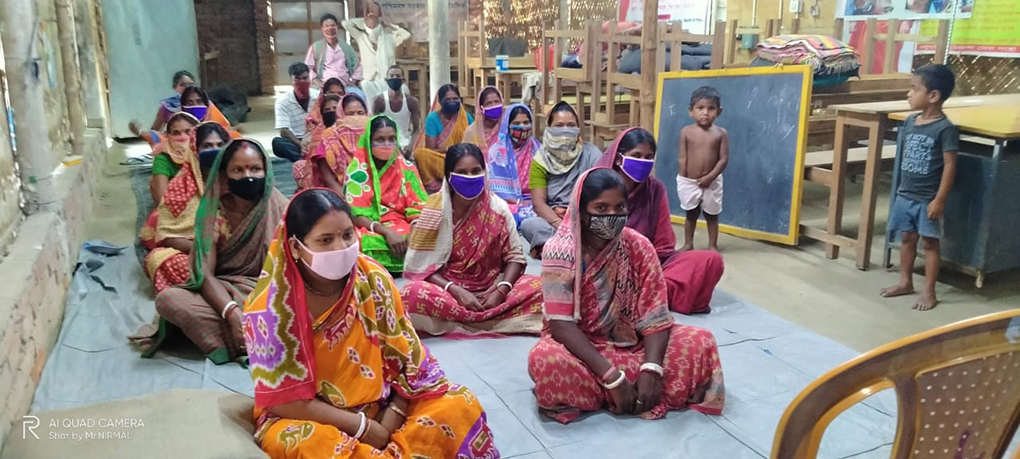
Women in a school designated as a cyclone shelter, but now also being used as a Covid-19 quarantine centre, in Kulagachi village of Deulia Panchayat in the northern part of the Sundarbans [image courtesy Sundarban TV]
In Bangladesh, Enamur Rahman, the minister for disaster management and relief, said on Monday that cyclone shelters were being prepared so that evacuees may maintain physical distance. “We have instructed the DCs (deputy commissioners) in the coastal districts to prepare an additional number of shelters so that people can take shelter there maintaining social distancing measures.”
Bangladesh is geared up to evacuate over five million people, and over 12,000 cyclone shelters have already been prepared. Officials and volunteers are going around the villages along the coast, asking people to move to shelters. Emergency evacuation has been planned as far east as Barishal and Chattogram districts, though these areas are not forecast to be badly affected unless the cyclone alters course the way Bulbul did.
According to the Department of Disaster Management, Bangladesh has around 4,500 cyclone shelters, each able to house anywhere between 600-1,200 people. But that does not take the Covid-19-forced distancing norms into account. Now the government has brought the number up to 12,000 by asking local officials to use all schools, colleges and seminaries in the coastal districts as cyclone shelters. But there is no word on how to ensure distancing there or in the regular shelters to avoid the virus infection.
![Cyclone shelter at Kalabogi village, in the Khulna division of Bangladesh, close to the Bay of Bengal coast; the shelters are typically built on stilts so that livestock can be housed at the ground level [image by: Alamy]](https://dialogue.earth/content/uploads/2020/05/cyclone-shelter-Kalabogi-village-Khulna-division-Alamy.jpg)
The Bangladesh government is providing 100 tons of rice, Taka 3.1 million (USD 36,454) for baby food and Taka 2.8 million (USD 32,926) for fodder as emergency support; 4,200 packets of dry food have been sent to the shelters as reserve.
The climate change connect
In line with the forecast from the Intergovernmental Panel on Climate Change, cyclones have become more frequent and more severe. Amphan is coming when many residents of the Sundarbans are still reeling from Cyclone Bulbul that hit the region last November. That cyclone moved almost parallel to the coast from west to east, its intensity significantly reduced by the world’s largest mangrove forest – the Sundarbans. But the forest, and the people living in and around it, were hit hard.
See: Mangrove forest saves Bengal from Cyclone Bulbul
One reason why the current Cyclone Amphan strengthened in intensity over last weekend at world record speed, making it the strongest cyclone in the Bay of Bengal since meteorologists started keeping regular records in 1982, is sea surface temperature. Crossing 31 degrees Celsius last weekend, the temperature on the surface of the Bay of Bengal was the highest recorded. That meant a lot more water evaporated from the sea surface to add to the storm clouds.
At its most intense, while still out at sea, Amphan’s wind speed near the centre was 215-225 kilometres per hour, with gusts going up to 245 kmph. It started losing some of its intensity by Tuesday evening.
Detailed forecasts, positive effect
The detailed tracking of the cyclone and repeated forecasts since last weekend by the meteorological departments of Bangladesh and India has already had one positive fallout – almost all the fishing boats out in the Bay of Bengal are already back at port, according to officials in the West Bengal fisheries department. Fishers from Bangladesh are anyway banned from going to out to sea during this breeding season every year.
Monwar Hossain, a senior official at the Bangladesh Meteorological Department (BMD) said on Monday that any fishing boat or trawler that may still be out at sea has been advised to take shelter immediately and remain in shelter till further notice. Ports from Kolkata in the west to Chattogram in the east have been closed down.
Apart from Kolkata, Cyclone Amphan is predicted to pass very close to Dhaka. Though it should have lost much its wind speed by then, heavy rainfall has been forecast. In both cities, residents of brick and concrete houses have also been advised to batten down, put sticky tape on windows, bring flowerpots indoors and ensure that there is no loose material lying around.
Chowdhury of YPSA said on Monday, “The (Bangladesh) government is currently busy tackling the Covid-19 crisis, but it is important to have all possible preparation and evacuation plan for the cyclone in place well ahead of time so that nothing is left for the last minute. Our volunteers are now going to the communities to keep them informed about the cyclone, but people do not seem to be listening to the warnings. We think the government could have started the preparedness work as soon as the BMD informed about the cyclone a few days ago.”
![<p>Residents of the coastal region Bhola in Bangladesh being evacuated to shelters on Tuesday in anticipation of Cyclone Amphan [image by: Chhoton Saha]</p>](https://dialogue.earth/content/uploads/2020/05/Bhola-Amphan-evacuation-19-May-Chhoton-Saha.jpg)
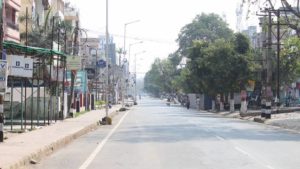


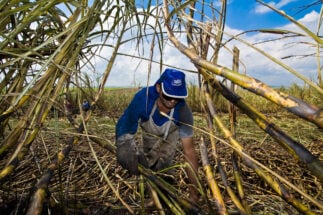
![Indians wearing protective masks stand with their luggage in queue outside a railway station [image: Alamy]](https://dialogue.earth/content/uploads/2020/05/indians-protective-masks-300x200.jpg)

